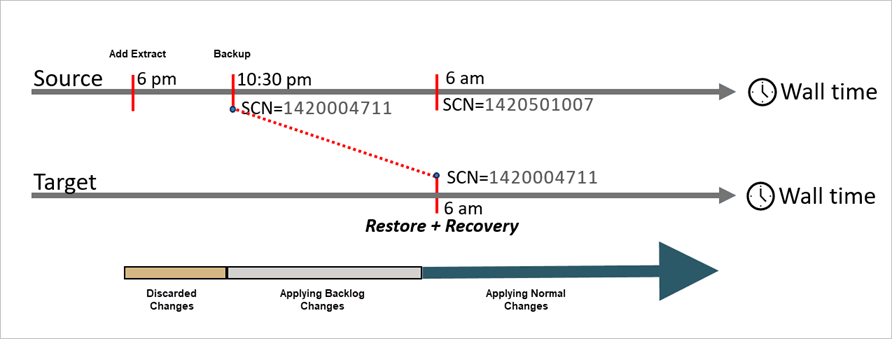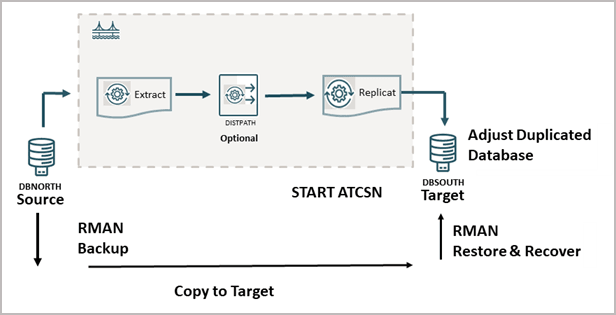Using Recovery Manager (RMAN) for Instantiation
The Recovery Manager (RMAN) method of instantiating a target Oracle database is suitable for providing a physical, block-based instantiation which offers faster performance for large-scale data transfers. The RMAN process creates the target database by restoring a backup of the source database.
For large databases that are in the terabyte range, logical instantiation methods can be time-consuming and inefficient. In such cases, Oracle RMAN is a preferred solution for creating a physical clone of the source database.
-
Use a backup of the source database.
-
Restore the backup to a new auxiliary (cloned) database.
-
Perform media recovery on the cloned database to bring it to a consistent state.
-
Configure and adjust the cloned database to meet the specific requirements of the target environment.
When using RMAN cloning for Oracle GoldenGate, it’s important to manage the timing of replication to avoid data loss and ensure seamless integration. The key is to identify the point in time (or SCN) when the target database was consistent, so that both the source and target databases stay in sync.
To do this, start the Oracle GoldenGate Extract process on the source database before the backup is taken. If you find a transaction that has an older timestamp than when you registered Extract, you must wait until that transaction has completed. This is important as Extract only processes complete transactions. After the target system is set up through cloning, direct the replication changes to the target system using the DISTPATH and add the Replicat process. When you start the Replicat, make sure to start exactly at the SCN where the target database was recovered.
The following example explains the use of SCN when cloing a database using the backup from the source database.
On the source database, the backup, which is scheduled at 10 PM, is running. The
backup includes database files and archive logs, which are backed up more
frequently. The backup finishes at 10:30 PM with an SCN of 1420004711. This backup
is then used to clone (restore and recover) the new target database. File copying,
restore, and recovery take several hours, after which, the new target database is
ready. At this point, both the source and target databases are consistent, as shown
in the following diagram.
As time passes, new changes continue to occur on the source database, and its SCN increases. To keep the target database in sync, Oracle GoldenGate’s Extract process captures changes starting from a point before the backup was taken.
Even though the Replicat process is not started immediately, when it is, it will
ignore any changes that occurred before the STARTCSN (the SCN to
which the target database was recovered). After that point, Replicat begins applying
the backlog of changes. After Replicat is in sync, replication transitions into the
normal, real-time phase.
Refer to the Duplicating Databases topic in the Oracle Database Backup and Recovery User’s Guide, which provides detailed steps to set up a cloneed target database using RMAN.
Precise Instantiation for Oracle Using the RMAN Method
-
Install and set up Oracle GoldenGate by deploying the software on both the source and target systems. Before configuring anything, make sure all database prerequisites are met. This includes enabling minimal supplemental logging on the source database, and using
ADD TRANDATAorADD SCHEMATRANDATAto ensure key columns in the replicated tables are logged. -
Add and configure the Extract and DISTPATH processes on the source database.
-
Add and configure the Replicat process on the target database.
- Start the Extract process and make sure that Extract starts running before any long-running transactions begin because Extract only captures complete transactions.
-
Start the DISTPATH process.
-
Do not start the Replicat process. wait until the target database has been fully recovered.
-
Use RMAN to take a backup of the source database. This backup will be used later to create the target database. The backup files need to be securely transferred to the target system.
RMAN target / RMAN> BACKUP DATABASE PLUS ARCHIVELOG -
Use RMAN to create a duplicate of the source database and rename it as the target database name. For example, if the target database name is DBSOUTH, then rename the duplicate of the source database as DBSOUTH. Make sure to note the SCN (System Change Number) value during this process, as it marks the exact point in time where both databases are in sync. The following example displays the creation of a duplicate of the
DBNORTHdatabase, which is named asDBSOUTH(same as the target database).OS> RMAN target / RMAN> restore database preview summary >>> Recovery must be done beyond SCN 1420004711 to clear datafile fuzziness OS> target sys/tiger99_RR@dbnorth RMAN> connect auxiliary RMAN> duplicate target database to DBSOUTH nofilenamecheck until SCN 1420004711; -
Start the Replicat process on the
DBSOUTHdatabase, making sure it starts exactly at the same SCN as the database that was recovered using RMAN.Use the
ATSCNoption to ensure there is no data gap during replication:OGG http://www.example.com:12000 depl_south> START REPLICAT REPS, ATCSN 1420004711
The following diagram illustrates these steps: